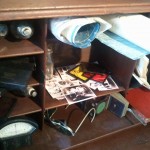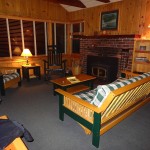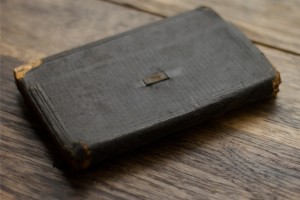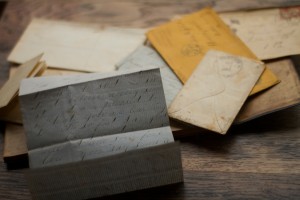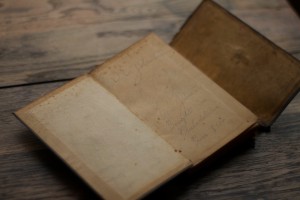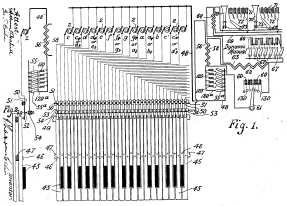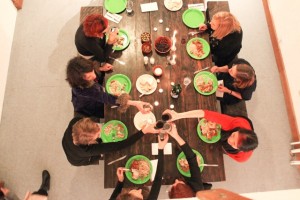I asked a dear friend of mine, Timothy Smith-Stewart, to set a few parameters for me to work within/off… as a sort of sub-print series. Freeing it can be to have a few rules set in place. Something I have definitely done for myself the past few years working primarily with woodblocks.
And Tim’s problems? (I guess my problems now…) I didn’t know what to expect, but they are definitely set to push one into new realms through process.
And a bit about Tim: multi discipline performance sorta fellow, very social cause oriented. Great at bringing many different folks from all different backgrounds together in projects and collaborations.
PROBLEMS:
Problem 1
- a: Pick three books off your shelf that have been meaningful in your life (or just pick the first you see).
- b: Take the one that looks the oldest.
- c: Flip to page 75.
- d: Read the page and pick in an image, a moment, a scene or a sentence.
- e: 10 minutes to recreate the image; anyway that best captures the image.
- f: Eat something.
- g: 1 hour to specify the image.
Problem 2
- a: Set your alarm for 3:45am
- b: Go to sleep at a normalish time.
- c: When the alarm goes off immediately start recreating the last image that was in your dream.
- d: Once its recreated go back to sleep.
- e: When you wake up spend 30 hour specifying the image.
Problem 3
- a: Sit in your awesome meditation hut with tools create images pencil, paper etc lots of paper.
- b: Just sit for 20 minutes only focusing on your breath in your body, you can’t smoke.
- c: After 20 minutes. Spend ten minutes writing a memory. What ever comes up. one probably came up while you were sitting there breathing.
- d: Put the paper down, for 10 minutes explore the hut, and the surrounding area. Find as many patterns as possible, in the carved wood, in the paint, in the ground in the trees, maybe unintentional patterns.
- e: Sit back down. As quickly as you can draw as many patterns as possible.
- f: Go back inside. Pick your favorite pattern. Draw your memory using the patterns.
Problem 4
- a: Get some paper and a pen.
- b: Set a timer for 15 minutes. free write, non-stop writing for 15 minutes on the problem below.
- c: Why? Why not? Why should you not be doing what you’re doing? Why should you be doing something else? What are those other things? What do they look like?
- d: Pick one image that excites you or makes you mad or scares you.
- e: Recreate the image.
Problem 5
- a: Read the first part of Futurist Manifesto. below. (next step after text.) F. T. Marinetti, 1909
- b: Recreate 5 images from the manifesto.
- c: Finish your favorite image.
- d: Write a sentence or two of your manifesto, recognizing its a fluid constantly shifting dream your attempting to codify and define in one place and time.
(THANKS TIM!) I’ll be chipping away at these the next few weeks with posts along the way- keep tuned for results.
A note from TPR Founder Jess: The idea for this exercise came to Charles after watching The Five Obstructions in TPR last fall. More about the film and its influence can be found here.
And visit Charles while he wrestles with these obstructions on Saturdays twice a month from 1-4pm. Check the calendar for specific dates!
2 Comments | Posted in: Projects | Permalink to this post
Follow-up:
charlie says:
March 10, 2012 at 9:27 pm (Edit)
And the manifesto for Problem No. 5!:
We have been up all night, my friends and I, beneath mosque lamps whose brass cupolas are bright as our souls, because like them they were illuminated by the internal glow of electric hearts. And trampling underfoot our native sloth on opulent Persian carpets, we have been discussing right up to the limits of logic and scrawling the paper with demented writing.
Our hearts were filled with an immense pride at feeling ourselves standing quite alone, like lighthouses or like the sentinels in an outpost, facing the army of enemy stars encamped in their celestial bivouacs. Alone with the engineers in the infernal stokeholes of great ships, alone with the black spirits which rage in the belly of rogue locomotives, alone with the drunkards beating their wings against the walls.
Then we were suddenly distracted by the rumbling of huge double decker trams that went leaping by, streaked with light like the villages celebrating their festivals, which the Po in flood suddenly knocks down and uproots, and, in the rapids and eddies of a deluge, drags down to the sea.
Then the silence increased. As we listened to the last faint prayer of the old canal and the crumbling of the bones of the moribund palaces with their green growth of beard, suddenly the hungry automobiles roared beneath our windows.
“Come, my friends!” I said. “Let us go! At last Mythology and the mystic cult of the ideal have been left behind. We are going to be present at the birth of the centaur and we shall soon see the first angels fly! We must break down the gates of life to test the bolts and the padlocks! Let us go! Here is they very first sunrise on earth! Nothing equals the splendor of its red sword which strikes for the first time in our millennial darkness.”
We went up to the three snorting machines to caress their breasts. I lay along mine like a corpse on its bier, but I suddenly revived again beneath the steering wheel — a guillotine knife — which threatened my stomach. A great sweep of madness brought us sharply back to ourselves and drove us through the streets, steep and deep, like dried up torrents. Here and there unhappy lamps in the windows taught us to despise our mathematical eyes. “Smell,” I exclaimed, “smell is good enough for wild beasts!”
And we hunted, like young lions, death with its black fur dappled with pale crosses, who ran before us in the vast violet sky, palpable and living.
And yet we had no ideal Mistress stretching her form up to the clouds, nor yet a cruel Queen to whom to offer our corpses twisted into the shape of Byzantine rings! No reason to die unless it is the desire to be rid of the too great weight of our courage!
We drove on, crushing beneath our burning wheels, like shirt-collars under the iron, the watch dogs on the steps of the houses.
Death, tamed, went in front of me at each corner offering me his hand nicely, and sometimes lay on the ground with a noise of creaking jaws giving me velvet glances from the bottom of puddles.
“Let us leave good sense behind like a hideous husk and let us hurl ourselves, like fruit spiced with pride, into the immense mouth and breast of the world! Let us feed the unknown, not from despair, but simply to enrich the unfathomable reservoirs of the Absurd!”
As soon as I had said these words, I turned sharply back on my tracks with the mad intoxication of puppies biting their tails, and suddenly there were two cyclists disapproving of me and tottering in front of me like two persuasive but contradictory reasons. Their stupid swaying got in my way. What a bore! Pouah! I stopped short, and in disgust hurled myself — vlan! — head over heels in a ditch.
Oh, maternal ditch, half full of muddy water! A factory gutter! I savored a mouthful of strengthening muck which recalled the black teat of my Sudanese nurse!
As I raised my body, mud-spattered and smelly, I felt the red hot poker of joy deliciously pierce my heart. A crowd of fishermen and gouty naturalists crowded terrified around this marvel. With patient and tentative care they raised high enormous grappling irons to fish up my car, like a vast shark that had run aground. It rose slowly leaving in the ditch, like scales, its heavy coachwork of good sense and its upholstery of comfort.
We thought it was dead, my good shark, but I woke it with a single caress of its powerful back, and it was revived running as fast as it could on its fins.
Then with my face covered in good factory mud, covered with metal scratches, useless sweat and celestial grime, amidst the complaint of staid fishermen and angry naturalists, we dictated our first will and testament to all the living men on earth.








